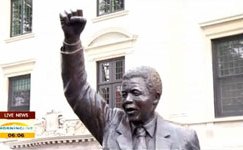
Mandela statue unveiled in Washington
A nine-foot (three-metre) statue of Nelson Mandela – showing him with fist raised as he walked out of Victor Verster prison a free man on 11 February 1990 – was unveiled outside the entrance to South Africa’s embassy in Washington, DC on Saturday. The statue, a copy of one that stands outside the Drakenstein Correctional […]


A nine-foot (three-metre) statue of Nelson Mandela – showing him with fist raised as he walked out of Victor Verster prison a free man on 11 February 1990 – was unveiled outside the entrance to South Africa’s embassy in Washington, DC on Saturday.
The statue, a copy of one that stands outside the Drakenstein Correctional Facility (formerly Victor Verster Prison) near Cape Town, where Mandela spent his final years in prison, was modelled by Cape Town sculptor Jean Doyle from photographs of Mandela striding triumphantly to freedom after 28 years of incarceration.
Facing onto Massachusetts Avenue, an artery that takes much of Washington’s elite to its offices downtown, the statue stands on the spot where, in the mid-1980s, thousands of American anti-apartheid protesters symbolically surrendered their liberty under the banner of the Free South Africa Movement.
Among those present at Saturday’s unveiling were Mandela’s daughter Zindzi, National Congress (ANC) chairwoman Baleka Mbete, International Relations Minister Maite Nkoana-Mashabane, and Anant Singh, producer of the big-screen dramatisation of Mandela’s autobiography Long Walk To Freedom, which had a successful debut at the Toronto Film Festival earlier this month.
The US was be represented by senior administration officials, members of Congress and civil rights leaders, including the four whose sit-in and arrest at the embassy on 21 November 1984 marked the birth of the Free South Africa Movement.
They were Randall Robinson, founder of TransAfrica, Mary Frances Berry, former chair of the US Civil Right Commission, Congresswoman Eleanor Holmes Norton, and her predecessor as DC delegate, Rev Walter Fauntroy.
The Free South Africa Movement
Almost every day from Thanksgiving 1983 through the following year, a cross-section of American society, from congressional leaders and celebrities like Stevie Wonder to mothers pushing strollers, gathered at the South African embassy and peaceably had themselves arrested for trespass.
The campaign built momentum toward passage of the 1986 Comprehensive Anti-Apartheid Act (CAAA), a bipartisan measure adopted over President Reagan’s veto (as retold in the current hit filmThe Butler) to put pressure on Pretoria to release Mandela and other political prisoners and begin negotiations for a new non-racial democratic order.
Skadden Arps partner and former White House chief counsel Greg Craig, who as foreign policy adviser to the late Senator Edward Kennedy played a significant role in crafting the CAAA, supported the statue project with legal services.
A plaque at the base of the statue quotes from Mandela’s address to a joint session of Congress months after his release in 1990:
- “The stand you took established … that here we have friends … fighters against racism who feel hurt because we are hurt, who seek our success because they too seek the victory of democracy over tyranny. I speak … of the millions of people throughout this great land who stood up and engaged the apartheid system in struggle. Let us keep our arms locked together so that we form a solid phalanx against racism … Let us ensure that justice triumphs without delay.”
‘Golden triangle’ of monuments to leaders
South African Ambassador Ebrahim Rasool commented recently: “We like to think this statue completes a golden triangle of monuments to leaders – Mahatma Ghandi, Dr Martin Luther King and now Nelson Mandela – who have shown by their examples that while the arm of the universe is long, it does not only tend towards justice of its own accord, it can be hastened in that direction peacefully by inspired leadership.”
Simon Barber, US country manager for Brand South Africa, said: “Decisions that affect the world are made by men and women – including the US vice-president – who pass this way every day on their way to and from work. We hope they may draw inspiration from this reminder of a great South African.”
Across the road is a statue of Winston Churchill, placed in front of the British ambassador’s residence in 1966 by the English Speaking Union, with right hand raised in the trademark Churchill V-for-victory. Mandela’s right hand is raised in the fist of a power salute.
“As you know,” Ambassador Rasool said with a grin, “rock beats scissors”.
By: South African Embassy, Washington DC and SAinfo reporter
Source:www.southafrica.info
